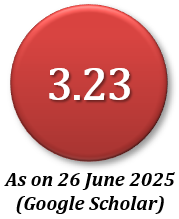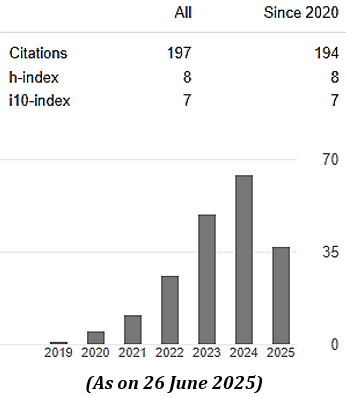Link Budget Analysis in Designing a Web-application Tool for Military X-Band Satellite Communication
Abstract
In satellite communication, Link Budget analysis is the most important part to determine gains and losses of signals from the transmitter to the receiver. Most importantly, it investigates system performance and optimum power which must be received at the receiver channel. In some cases, this information could be generated, saved for past data analysis, and share with peer users which are not found in existing web tools. Thus, it is obvious to design a new Link Budget calculator with users, database, and data retrieval support. This work focuses on designing a Link Budget web tool for X-band satellite communication through literature study and comparative analysis. The X-Band calculator is designed based on HTML, PHP, Javascript, and MySQL by ensuring several security issues, and can be accessed through mobile devices. This paper also focuses on the necessary equations of Link Budget for Uplink (Tx); Satellite; Downlink (Rx); Azimuth, Elevation, Distance analysis; and Rain attenuation. Though, comparative assessments among various web tools show some fluctuations, overall outputs show satisfactory results with small % of Errors (PoE) ensuring reliability and viability of the proposed X-Band tool for practical use.
Downloads
References
Abdullah, A. I., Ismail, A. F., Badron, K., & Hashim, W. (2018). Fade Margin Estimations for Malaysian Armed Forces Military X-Band Satellite Communication Links. International Journal of Future Generation Communication and Networking, 11(3), 1-10.
Adhikari, A., Das, S., Bhattacharya, A., & Maitra, A. (2011). Improving Rain Attenuation Estimation: Mod-Elling of Effective Path Length Using Ku-Band Measurements at A Tropical Location. Progress in Electromagnetics Research B, 34, 173-186
Al-Dalowi, A.H., Khoshnaw, A.I., & QasMarrogy, G.A. (2017, March 29-30). Satellite Link Budget Calculator by Using MATLAB/GUI. 1st International Conference of Cihan University-Erbil on Communication Engineering and Computer Science (CIC-COCOS’17), Cihan University-Erbil, Kurdistan Region-Iraq, 74-78.
Al-Saegh, A. M., Sali, A., Mandeep, J. S., Ismail, A., Al-Jumaily, A. H. J., & Gomes, C. (2014). Atmospheric Propagation Model for Satellite Communications. In Bennett, K. (Eds.), MATLAB Applications for the Practical Engineer, Chapter: 9, INTECH, (pp. 249-275), DOI: 10.5772/58238.
Bazzi, A., Giorgetti, A., Pasolini, G., & Schena, V. (2005). Gap Fillers for Railway Tunnels: Technologies and Performance. EMC Europe Workshop, Rome, Italy, 147-150.
Cakaj, S., Keim, W., & Malarić, K., (2007, May 30 - June 1). Communications Duration with Low Earth Orbiting Satellites. Proceedings of the Fourth IASTED International Conference on Antennas, Radar, and Wave Propagation, Montreal, Quebec, Canada, (pp. 85-88).
Capela, C. J. R. (2012). Protocol of Communications for Vorsat Satellite (Link Budget) [Master Thesis, Master Degree in Electrical Engineering]. Faculdade de Engenharia, Universidade do Porto.
Cole, C. E. (2010). Missile Communication Links. Johns Hopkins APL Technical Digest, 28(4), 324-330.
Cross, D. (2020). Azimuth/Distance calculator. Extracted on 18th Apr. 2020. Source: http://cosinekitty.com/compass.html
CS (2016). The Link Budget and Fade Margin: Application Note. Campbell Scientific Inc., Copyright 2016. App. Note Code: 3RF-F.
Elechi, P., & Otasowie, P. O. (2016). Comparison of Empirical Path Loss Propagation Models with Building Penetration Path Loss Model. International Journal on Communications Antenna and Propagation (I.Re.C.A.P.), 6(2), 116-123. DOI: 10.15866/irecap.v6i2.8013
Elbert, B. R. (2004). The Satellite Communication Applications Handbook (Second Edition). Chapter 12: Frequency Coordination and Regulation of Services. Artech House, Inc., 685 Canton Street, Norwood, MA 02062, (pp. 445-482).
everithingRF (2015). RF Calculators. Extracted on 20th Apr. 2020. Source: https://www.everythingrf.com/rf-calculators
Fadilah, N., & Pratama, R. (2018). Comparison of rain attenuation estimation in high frequency in Indonesia region for LAPAN communication satellite. 6th International Seminar of Aerospace Science and Technology, IOP Conf. Series: Journal of Physics: Conf. Series 1130 (2018) 012036, IOP Publishing, (pp. 1-7), DOI: 10.1088/1742-6596/1130/1/012036
Geyer, M. (2016). Earth-referenced Aircraft Navigation and Surveillance Analysis, Project Memorandum — June 2016, DOT-VNTSC-FAA-16-12, Prepared for: Federal Aviation Administration Wake Turbulence Research Office, U.S. Department of Transportation Research and Innovative Technology Administration, John A. Volpe Transportation Systems Center, (pp. 2.1-2.13).
Griffiths, H., Cohen, L., Watts, S., Mokole, E., Baker, C., Wicks, M., & Blunt, S. (2015, January). Radar Spectrum Engineering and Management: Technical and Regulatory Issues. Proceedings of the IEEE, 103(1), 85-102, DOI: 10.1109/JPROC.2014.2365517
Hyde, G., & Bargellini, P. L. (2002). Satellite and Space Communications. In Middleton, W. M., & Valkenburg, M. E. V. (Eds.), Reference Data for Engineers: Radio, Electronics, Computer, and Communications, 9th Edition, Elsevier Inc. (pp. 27.11 – 27.12).
Hossain, M. S. & Islam, M. A. (2017, February 16-18). Estimation of Rain Attenuation at EHF bands for Earth-to-Satellite Links in Bangladesh. International Conference on Electrical, Computer and Communication Engineering (ECCE), Cox’s Bazar, Bangladesh (pp. 589-593).
Ippolito L. J. (1986). Chapter 5: Rain Attenuation Prediction Methods. In Radiowave Propagation in Satellite Communications. Springer, Dordrecht, DOI: https://doi.org/10.1007/978-94-011-7027-7_5
Ismail, A. F., Zhiger, S., Hasan, M. K., & Hashim, W. (2017). An Intuitive Link Budget Tool for Military Satellite Communication. International Journal of Software Engineering and Its Applications, NADIA, 11(2), 97-106.
ITU (2011). Handbook, Earth Exploration–Satellite Service. English Edition 2011, Recommendation Bureau, ITU.
ITU-R (2003a). Propagation data and prediction methods required for the design of Earth-space telecommunication systems, (Question ITU-R 206/3), RECOMMENDATION ITU-R P.618-8, Rec. ITU-R P.618-8.
ITU-R (2003b). Specific attenuation model for rain for use in prediction methods, (Question ITU-R 201/3), RECOMMENDATION ITU-R P.838-2, Rec. ITU-R P.838-2.
ITU-R (2005). Specific attenuation model for rain for use in prediction methods, (Question ITU-R 201/3), RECOMMENDATION ITU-R P.838-3, Rec. ITU-R P.838-3.
Johnston, E. (2019). Satellite Link Budget Calculator. Satellite Signals Limited. Extracted on 24th Apr. 2020. Source: https://www.satsig.net/linkbugt.htm
Kanellopoulos, J. D., Panagopoulos, A. D., & Livieratos, S. N. (2000). Differential Rain Attenuation Statistics Including an Accurate Estimation of the Effective Slant Path Lengths. Progress in Electromagnetics Research, PIER 28, 97–120, DOI: 10.2528/PIER99060503
Karim, S. M. R., Sakib, S., Islam, M. T., & Ahamed, F. A. S. (2018). A Review of Communications Satellite by Focusing on ‘Bangabandhu Satellite-1’, the First GEO Communications Satellite of Bangladesh. International Journal of Networks and Communications, 8(5), 123-128, DOI: 10.5923/j.ijnc.20180805.01
Kestwal, M. C., Joshi, S., & Garia, L. S. (2014). Prediction of Rain Attenuation and Impact of Rain in Wave Propagation at Microwave Frequency for Tropical Region (Uttarakhand, India). International Journal of Microwave Science and Technology, Hindawi Publishing Corporation, 2014, 1-6, DOI: http://dx.doi.org/10.1155/2014/958498
KYMETA (2019). Link Budget Calculations for A Satellite Link with an Electronically Steerable Antenna Terminal. Kymeta Corporation and its affiliates.
Lwas, A. K., Islam, M. R., Habaebi, M. H., Mandeep, S. J., Ismail, A. F., Daoud, J. I., & Zyoud, A. (2015). A Modified Effective Path Length for Predicting Rain Attenuation Based on Measurements in Penang-Malaysia. ARPN Journal of Engineering and Applied Sciences, 10(21), 10096-10100.
Mahmud, M. R. A., & Khan, Z. S. (2009, September). Analysis and Planning Microwave Link to Established Efficient Wireless Communications [Master thesis, Master of Science in Electrical Engineering]. Department of Signal Processing, School of Engineering, Blekinge Institute of Technology.
Mantoro, T., Akhtaruzzaman, M., Mahmud, M., & Ayu, M. A. (2015). Design and Development of an Interactive Monitoring System for Pilgrims in Congregation of Hajj Ritual. Journal of Convergence Information Technology (JCIT), 10(1), 28-57.
Mebrek, M. A., Abderrahmane, L. H., Himeur, A., & Bendoukha, S. (2012). Configuration and the Calculation of Link Budget for a Connection via a Geostationary Satellite for Multimedia Application in the Ka band. International Journal of Electronics and Communication Engineering, World Academy of Science, Engineering and Technology, 6(4), 466-470.
Medvedev, P. A., Bykov, L. V., Bykov, V. L., Novorodskaya, M. V., & Sherstneva, S. I. (2018). Methods for Transformation of Rectangular Spatial Coordinates to Geodetic Coordinates. International Journal of Engineering & Technology (IJET), 7(4.38), 1179-1186.
Mello, L. d. S., & Pontes, M. S. (2012). Unified Method for the Prediction of Rain Attenuation in Satellite and Terrestrial Links. Journal of Microwaves, Optoelectronics and Electromagnetic Applications, 11(1), 1-14.
Mir, H., Cui, X., Shahzad, A., & Jumani, R, (2018). Optimization of Satellite Link to Earth Station Using Satellite Tool Kit (STK). International Journal of Electrical, Electronics and Data Communication, 6(12), 48-52.
Nizam, S. J. (2008, April 19). Military Application of Satellite. The Daily Star, Bangladesh.
Nuroddin, A. C. M., Ismail, A. F., Abdullah, K., Badron, K., Ismail, M., & Hashim, W. (2013). Rain Fade Estimations for the X-Band Satellite Communication Link in the Tropics. International Journal of Computer and Communication Engineering, 2(4), 408-412, DOI: 10.7763/IJCCE.2013.V2.215
OMNI (2020). Omni Calculator: Azimuth calculator. Extracted on 18th Apr. 2020. Source: https://www.omnicalculator.com/other
Panchal, P., & Joshi, R. (2016). Performance Analysis and Simulation of Rain Attenuation Models at 12–40 GHz Band for an Earth Space Path over Indian Cities. Procedia Computer Science, ELSEVIER, 79(2016), 801-808.
Panou, G., Korakitis, R., & Delikaraoglou, D. (2018). Cartesian to Geodetic Coordinates Conversion by an Iterative Geometrical Method. Quod Erat Demonstrandum – In quest of the ultimate geodetic insight, Special issue for Professor Emeritus Athanasios Dermanis, School of Rural and Surveying Engineering, AUTh, 274-281.
RACOM (2018). Application Notes, RACOM Radio Data Networks, Version 1.0, 7/12/2018, 1-17.
Ranjan, A., Panigrahi, B., Rath, H. K., Misra, P., Simha, A., & Sahu, H. B. (2018, February). A Study on Pathloss Model for UAV Based Urban Disaster and Emergency Communication Systems. IEEE Twenty Fourth National Conference on Communications (NCC), Hyderabad, India. DOI: 10.1109/NCC.2018.8600260
Roddy, D. (2006). The Geostationary Orbit (Chapter 3). In Satellite Communications, 4th Edition, McGraw-Hill, (pp. 77-101).
SatcomUK (2015). Satellite Link Budget Calculators. Extracted on 24th Apr. 2020. Source: http://www.satcoms.org.uk/satellite-link-budget-calculator.asp
Satcom Services Networks (2020). Link Budget Calculations: Geostationary Satellite Azimuth and Elevation Calculation. Extracted on 18th Apr. 2020. Source: https://satcom-services.com/VSAT/linkbudget.html
Shrestha, S., & Choi, D. Y. (2017). Characterization of Rain Specific Attenuation and Frequency Scaling Method for Satellite Communication in South Korea. International Journal of Antennas and Propagation, Hindawi, 2017, 1-16, DOI: https://doi.org/10.1155/2017/8694748
Shrestha, S., & Choi, D. Y. (2019). Rain Attenuation Study at Ku-Band over Earth-Space Path in South Korea. Advances in Astronomy, Hindawi, 2019, 1-12, DOI: https://doi.org/10.1155/2019/9538061
Soler, T. (1976). On differential transformations between Cartesian and curvilinear (geodetic) coordinates. Rep. No. 236, Dept. of Geodetic Sci., Ohio State Univ., Columbus, Ohio.
Soler, T., & Eisemann, D. W. (1994). Determination of Look Angles to Geostationary Communication Satellites. Journal of Surveying Engineering, 120(3), 115-127.
Song, H., & Schnieder, E. (2019). Development and Evaluation procedure of the Train-centric Communication based System. IEEE Transactions on Vehicular Technology, 68(3), 2035-2043, DOI: 10.1109/TVT.2018.2868881
Stutzman, W. L. (1998). Estimating Directivity and Gain of Antennas. IEEE Antennas and Propagation Magazine, 40(4), 7-11.
SWA (2020). South West Antennas, RF Calculators and Conversion Tools. Extracted on 18th Apr. 2020. Source: https://www.southwestantennas.com/rf-calculators-and-conversion-tools
TRANZEO (2010). Wireless Link Budget Analysis: How to Calculate Link Budget for Your Wireless Network. Tranzeo Wireless Technologies Inc., TR3014-01, 1-4, http://www.tranzeo.com/allowed/Tranzeo_Link_Budget_Whitepaper.pdf
TRIAXMAN (2020). SatLex: Calculator for azimuth and elevation angle. Extracted on 20th Apr. 2020. Source: https://satlex.de/en/azel_calc-params.html?satlo=7.0&user_satlo=7&user_satlo_dir=E&location=&la=41&lo=29&country_code=ng&diam_w=70&diam_h=75
TutorialsWeb (2020). A home for Tutorials; Satellite Look Angle Calculator: Azimuth and Elevation Angles Calculator. Extracted on 19th Apr. 2020. Source: https://www.tutorialsweb.com/satcom/calculation-of-satellite-look-angles.htm
Wangn, Y., Huynh, G., & Williamson, C. (2013). Integration of Google Maps/Earth with microscale meteorology modelsand data visualization. Computers & Geosciences, 61(2013), 23-31.
Ya’acob, N., Tajudin, N., Sarnin, S. S., Rahim, S. A. E. A., & Manut, A. (2018). Link Budget and Noise Calculator for Satellite Communication. IOP Conf. Series: Journal of Physics: Conf. Series 1152 (2019) 012021, 1-7, DOI:10.1088/1742-6596/1152/1/012021
Yulianto, F. (2012). Link Budget Calculator Software Design with Microsoft Visual Basic. Jurusan Sistem Informasi, Sekolah Tinggi Manajemen Informatika Dan Komputer, Amikom Yogyakarta.
Yussuff, A. I. O., & Khamis, N. H. H. (2013). Modified ITU-R Rain Attenuation Prediction Model for a Tropical Station. Journal of Industrial and Intelligent Information, Engineering and Technology Publishing, 1(3), 155-159, DOI: 10.12720/jiii.1.3.155-159
Zhiger, S. (2017). Development of an Intuitive Link Budget Tool for Military Satellite Communications [Master of Science thesis, IIUM]. International Islamic University Malaysia.
MIJST follows the open access policy.

This work is licensed under a Creative Commons Attribution-NonCommercial 4.0 International License. This allows anyone to copy, share, distribute, and modify the work for non-commercial purposes, where the original work and source should be properly credited.

















